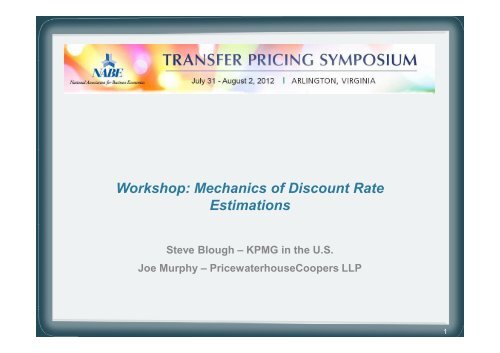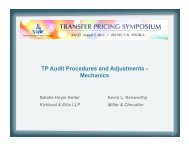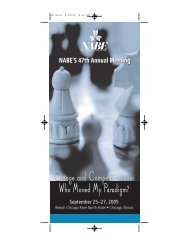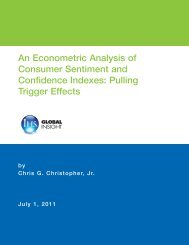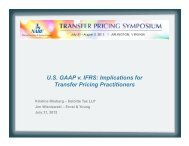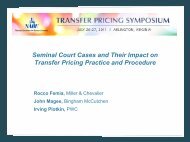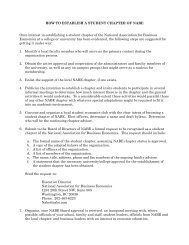Implied Discount rate - NABE
Implied Discount rate - NABE
Implied Discount rate - NABE
You also want an ePaper? Increase the reach of your titles
YUMPU automatically turns print PDFs into web optimized ePapers that Google loves.
NoticeANY TAX ADVICE IN THIS COMMUNICATION IS NOTINTENDED OR WRITTEN BY KPMG ORPRICEWATERHOUSECOOPERS LLP TO BE USED, ANDCANNOT BE USED, BY A CLIENT OR ANY OTHER PERSON ORENTITY FOR THE PURPOSE OF (i) AVOIDING PENALTIESTHAT MAY BE IMPOSED ON ANY TAXPAYER OR (ii)PROMOTING, MARKETING OR RECOMMENDING TOANOTHER PARTY ANY MATTERS ADDRESSED HEREIN.You (and your employees, representatives, or agents) may disclose to any and allpersons, without limitation, the tax treatment or tax structure, or both, of anytransaction described in the associated materials we provide to you, including, butnot limited to, any tax opinions, memoranda, or other tax analyses contained inthose materials.The information contained herein is of a general nature and based on authoritiesthat are subject to change. Applicability of the information to specific situationsshould be determined through consultation with your tax adviser.2
Agenda• Background• Measuring discount <strong>rate</strong>s• Income method under final cost sharing regulations• 2011 Temporary and proposed cost sharing regulations• <strong>Discount</strong> <strong>rate</strong>s used in different forms of payment3
Background• <strong>Discount</strong> <strong>rate</strong>s reflect/measure the risk associated with an expected cashflow.• Cost sharing regulations, and in particular the income method, increasedthe focus of discount <strong>rate</strong>s in transfer pricing.• The key question is how to identify and measure the appropriate discountto use with a given forecasted income. Important to understand:– the forecasts: do forecasts factor in the risk of failure, or reflect expected resultsif successful?– the forecast horizon: Financial results in the distant future are more uncertainthan those in the near future– the risk level of income to be discounted: Residual profits are more uncertainthan routine profits• Many concepts/formulas to measure discount <strong>rate</strong>s, e.g. WACC, WARA,the IRR4
Different <strong>Discount</strong> Rates• Weighted Average Cost of Capital (WACC)– Theoretical measure of the cost of acquiring capital based on the capital assetpricing method or other techniques – Widely used in finance• Internal Rate of Return (IRR)– Measures the <strong>rate</strong> of return on a cash flow earned from of a certain level ofinvestment• Weighted Average Return on Assets (WARA)– Reconciles total return of enterprise to <strong>rate</strong>s of return on specific asset classes• Observed interest <strong>rate</strong>s (e.g. borrowing <strong>rate</strong>s, venture capitalist <strong>rate</strong>s, etc..)5
Risk vs. Expected ReturnThe least liquid (riskiest) class of business assets require the highest returnNon-liquidNarrow MarketIntangibleAssetsEquityFinancedTangibleAssetsWorking CapitalDebtFinancedLiquidVersatileCashLowInvestment Return RequirementsHigh6
Example – Reconciling <strong>Discount</strong> RatesThe Business Portfolio of Assets—Risk and Return CharacteristicsAsset Type Value WeightRequiredReturnDollarReturnWeightedReturnTangible AssetsWorking Capital 200 8.1% 3.5% 7 0.28%Fixed Assets 475 19.2% 5.0% 24 0.96%Other Assets 50 2.0% 5.5% 3 0.11%Intangible AssetsTrade Name 250 10.1% 15.0% 38 1.52%Customer Relationships 1000 40.4% 16.0% 160 6.46%Goodwill 500 20.2% 20.0% 100 4.04%Total Business 2475 100.0% 331WARA 13.37% 13.37%• The 13% WARA calculated above should approximate the company’s WACC8
Income Method• Under the income method, the PCT payments are calculated as follows:(PV of cash flows from the cost sharing alternative) – (PV of cash flows from thelicensing alternative)• The final regulations emphasize further that the financial projections used in applyingthe income method are “necessarily the same” in comparing the cost sharingalternative to the licensing alternative• Consequently, differences between the discount <strong>rate</strong>s must reflect only thedifferences between the obligations undertaken under the two alternatives• The effective result is:– PCT Payor is left with a return for its “routine” functions and risk plus an appropriateexpected <strong>rate</strong> of return for its risky investment in intangible investment.– PCT Payee captures all future “economic profit” over and above the return for routinefunctions/risks• The PCT payments are primarily a function of:– <strong>Discount</strong> <strong>rate</strong> spread between the licensing and cost sharing alternatives– Projections regarding long-horizon expected profitability9
The Income Method illust<strong>rate</strong>d:PCT payor’s perspectiveProjected ProfitsBeforeIP DevelopmentCostsA B CProjected ProfitsUnder CostSharingAlternativeProjected ProfitsUnder LicensingAlternativeYear 1 0 -20 0Year 2 100 100 40Total 100 80 40PCTPayment(=PV of A –PV of B)<strong>Discount</strong> Rates 17% 8%Present Values $55.26 $34.29 $21.66Alternative <strong>Discount</strong> Rates 15% 12%Present Values $58.22 $31.89 $26.3310
Financial Projections and <strong>Discount</strong> Rates• Financial projections for the licensing and cost sharing alternatives are interrelated– Projections are the same except for licensing payments under licensingalternative, and cost contributions and PCT payments under cost sharingalternative– Thus, income method builds off of single probability-weighted financialprojections associated with the CSA activity• <strong>Discount</strong> <strong>rate</strong>s for licensing and cost sharing alternatives are interrelated; anydifference is solely due to– (1) incremental risk associated with cost contributions undertaken in cost sharingalternative, and– (2) risk associated with different payment forms• Are management long-term forecasts (if they even exist) true long-term probabilityweightedfinancial projections accounting for the risk of failure?– Potential use of venture capital discount <strong>rate</strong>s as an alternative to “haircut” onforecasts.11
The 2011 temporary regulations• The preamble to the 2011 temporary regulations states that the IRS and Treasury“are aware” that some taxpayers have applied the income method by using anunrealistically low discount <strong>rate</strong> for the licensing alternative and an unrealisticallyhigh discount <strong>rate</strong> for the cost sharing alternative– The high discount <strong>rate</strong> spread between the two alternatives results in a lowerPCT Payment• The final regulations state that discount <strong>rate</strong> for the cost sharing alternative and thelicensing alternative are “closely related” because both are derived from the “singleprobability-weighted financial projections. That any differences in discount <strong>rate</strong>sshould only reflect:Incremental risk associated with developing cost shared intangibles and makingR&D cost contributions versus making licensing paymentsPayment forms of the licensing payments and the PCT payments (e.g., a royaltybased on sale vs. fixed PCT Payments)12
The 2011 temporary regulations: differential incomestream• The 2011 temporary regulations introduce the concept of the “implied discount <strong>rate</strong>”of the “differential income stream” between the two alternatives– The “differential income stream” is defined as the difference between theundiscounted income streams under the cost sharing and the licensingalternatives (akin to the residual income)– The “implied discount <strong>rate</strong>” of the “differential income stream” is the <strong>rate</strong> thatyields an equivalent value of the PCT as determined under the income methodusing different discount <strong>rate</strong>s for the two alternatives– The implied discount <strong>rate</strong> should be consistent with reliable direct evidence– WACC for uncontrolled companies developing intangibles similar to the costshared intangibles is suggested as a basis to determine the appropriate implieddiscount <strong>rate</strong>– The implied discount <strong>rate</strong> provides a basis for assessing whether the incomemethod has been reasonably applied13
The 2011 proposed regulations: differential incomestream• The 2011 proposed regulations carry the concept of the temporary regulationsfurther by proposing to use market evidence of discount <strong>rate</strong>s directly in a newlyspecified application of the income method――Determine the PCT obligation as the present discounted value of the differentialincome stream using an appropriate discount <strong>rate</strong> directly determined usingmarket evidenceWACC for uncontrolled companies developing intangibles similar to the costshared intangibles is suggested as a basis to determine a discount <strong>rate</strong>appropriate for the differential income stream• Both the temporary and the proposed regulations are designed to provide specificguidance on the selection of different discount <strong>rate</strong>s to prevent what the IRSperceives as inappropriate application of discount <strong>rate</strong> differentials to produceunderstated PCT values14
The “<strong>Implied</strong> <strong>Discount</strong> <strong>rate</strong>”: in practice• In practice, for a majority of cases it may be extremely difficult to observe directmarket evidence of the “implied discount <strong>rate</strong>”• An alternative is to derive the discount <strong>rate</strong> of the non-routine profit stream of thecost shared intangibles from the overall return.• Consider the equality: Operating profit = routine return + non-routine profit• Expressing in present value terms:NPV(Operating profit, R OI ) = NPV(routine return, R R ) + NPV(non-routine return, R NR )where,R OI = discount <strong>rate</strong> for operating profit (e.g., WACC)R R = discount <strong>rate</strong> for routine returnR NR = discount <strong>rate</strong> for non-routine profit• One approach to derive the discount <strong>rate</strong> of routine return may be to use the WACCsof routine comparables.• Re-arranging terms:NPV(non-routine return, R NR ) = NPV(Operating profit, R OI ) - NPV(routine return, R R )• Thus, implied discount <strong>rate</strong> for the non-routine profit stream may be derived as <strong>rate</strong>that solves the above equality (through iteration)• It is still prudent to perform a sanity check to determine that the derived discount <strong>rate</strong>is reasonable given market evidence15
<strong>Discount</strong> <strong>rate</strong>s illustration<strong>Discount</strong> Rate forresidual profitA B CRoutine Profits Total Profits DifferenceYear 1 0 -20Year 2 40 100Total 40 80DResidual Profits= (B – A)-206040<strong>Discount</strong> Rates 12% 15%Present Values $31.89 $58.22 $26.3317.67%$26.33Benchmarked by WACCsof comparablesAppropriate discount <strong>rate</strong> fortotal profit, e.g., WACCDerived <strong>rate</strong> that equates the presentvalue in D to the amount in CIncome method calculation in final regulationsIncome method calculation inproposed regulations16
2011 Temporary Regulations - Example 8• Two cost sharing participants; one has a PCT contribution which is valued usingIncome Method• The discount <strong>rate</strong>s for the cost sharing alternative is estimated at 20 percent andthat for the licensing alternative is estimated at 10 percent resulting in a $146 millionPCT• The Commissioner computes an “implied discount <strong>rate</strong>” by equating the net presentvalue of the “differential income stream” to the PCT value of $146 million, whichresulted in a “implied discount <strong>rate</strong>” of 34.4 percent• By analyzing comparable uncontrolled companies, the Commissioner concluded thata reasonable “implied discount <strong>rate</strong>” based on market evidence is about 16 percent• Thus the taxpayer’s analysis was deemed unreasonable and an adjustment wasissued17
2011 Proposed Regulations - Example 9• Two cost sharing participants; one has a PCT contribution which is valued usingIncome Method• The discount <strong>rate</strong>s for the cost sharing alternative is estimated at 15 percent andthat for the licensing alternative is estimated at 13 percent resulting in a $464 millionPCT• The Commissioner has additional data on discount <strong>rate</strong>s for comparable companies• Based on available data, the Commissioner determines that an appropriate range for“implied discount <strong>rate</strong>” is 15 percent or 17 percent• The PCT values are calculated as $446 million and $ 501 million, with 17 percentand 15 percent discount <strong>rate</strong>s, respectively• Since the taxpayer’s estimated PCT value lies between this range, it was deemedreasonable and no further adjustments issued18
Forms of Payment and <strong>Discount</strong> Rates• PCT payment may take the form of one-time lump sum payment, fixed installmentpayment or contingent payment• The final cost sharing regulations recognizes the difference in risk profilesassociated with different payment forms• A contingent payment based on sales will necessitate a different discount <strong>rate</strong> thanone that is based on profits or a fixed installment payment.• <strong>Discount</strong> <strong>rate</strong>s for operating profit stream may be estimated by the WACC or theWARA.How does one estimate a discount <strong>rate</strong> for the revenue stream?• Finance theory can provide a useful framework to analyze the interrelationshipsbetween discount <strong>rate</strong>s applicable to different cash flows to help estimate anapplicable discount <strong>rate</strong> for revenue/sales19
Forms of Payment and <strong>Discount</strong> Rate – <strong>Discount</strong> <strong>rate</strong>of revenue stream• Starting with a simple equality that holds every periodOperating Income = Revenue – Cost, where Cost = Fixed Costs + Variable Costs• Expressed in net present value terms over the relevant time horizon:where,NPV(Operating income, R OI ) = NPV(Revenue, R Rev ) – NPV(VC, R VC ) - NPV(FC,R FC )R OI = discount <strong>rate</strong> for Operating ProfitR Rev = discount <strong>rate</strong> for RevenueR VC = discount <strong>rate</strong> for Variable CostsR FC = discount <strong>rate</strong> for Fixed Costs• Finance literature suggest that revenue and variable costs have a high degree ofcovariance and thus they can be expected to have similar volatility/variability *• Thus, re-arranging terms:NPV(Operating income, R OI ) = NPV(Revenue - VC, R Rev ) - NPV(FC, R FC )* For example, see Brealey, R.A., and Myers, S.C; Principles of Corpo<strong>rate</strong> Finance 5th ed.; (1996) McGraw Hill Companies.20
<strong>Discount</strong> <strong>rate</strong> of revenue stream – Numerical example<strong>Discount</strong> Rate forrevenue streamA B C D = A – B – C C + DE = A – BRevenuesVariableCostsFixedCostsOperatingIncomeRevenue –Variable CostsYear 1 $100 $50 $20 $30Year 2 $90 $45 $10 $35Year 3 $120 $60 $25 $35$50$45$60<strong>Discount</strong>RatesPresentValues5% 12%$49.71 $79.60 $129.319%$129.31Appropriate discount <strong>rate</strong> forfixed costs, e.g., yields onlong-term corpo<strong>rate</strong> bondsAppropriate discount <strong>rate</strong>for operating income, e.g.,WACCDerived discount <strong>rate</strong> forrevenues that equates E to thesum of C and D in present valueterms22


